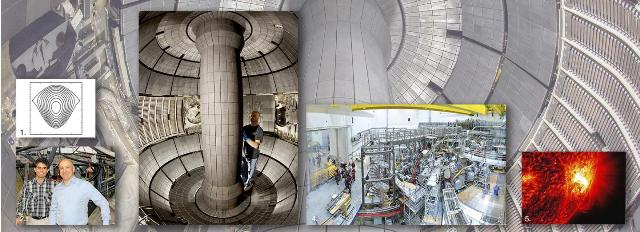Jan 13 2016

Image Credit: Shutterstock.com/AhuliLabutin
Researchers from the U.S. Department of Energy's Princeton Plasma Physics Laboratory (PPPL) have helped in pushing the boundaries of plasma science and clean energy research with numerous achievements such as introducing the most powerful spherical tokamak on Earth and discovering a mechanism to stop the progress of solar eruptions.
 Image credit: Elle Starkman/PPPL; Lisa Petrillo/GA for Carlos Paz-Soldan and Raffi Nazikian)
Image credit: Elle Starkman/PPPL; Lisa Petrillo/GA for Carlos Paz-Soldan and Raffi Nazikian)
Here are some of the top 5 key takeaways from the past twelve months:
Construction of the National Spherical Torus Experiment-Upgrade (NSTX-U) was completed
It is the laboratory's flagship fusion facility, and doubles the laboratory's magnetic power and heating, thereby making it the world’s most powerful spherical tokamak.
Unlike traditional donut-shaped fusion facilities, the machine resembles a cored apple, and is capable of creating high plasma pressure with relatively low magnetic fields, which is a very cost-effective feature as it is expensive to create magnetic fields.
The upgrade offers a versatile research platform, which will enable physicists to immediately tackle some of the key challenges relating to fusion.
Discoverey of an innovative mechanism capable of stalling solar eruptions
Basically, solar eruptions are radiation from the sun and huge plasma explosions, which can disturb cell phone service and other vital functions when they bump into the magnetic field circling the Earth, and can also be dangerous for space travelers.
The team of researchers involved in the Magnetic Reconnection Experiment (MRX), which is a one-of-a-kind device to analyze the separation and convergence of magnetic fields in plasma, have discovered a formerly unidentified mechanism capable of halting eruptions.
This finding is crucial for NASA, which is in need of data relating to when an eruption is about to occur and when the initial eruption is only a false alarm.
First plasma generated on the Wendelstein 7-X stellarator in Germany
PPPL, which heads the US collaboration with the W7-X stellarator, played a key role in the construction of the fusion device.
The laboratory will be conducting research on it, and has designed five barn-door size magnetic coils along with power supplies to assist in shaping the plasma during W7-X experiments.
An X-ray diagnostic system has also designed and installed by PPPL to enable collection of crucial data from the plasma in the machine.
Compared with tokamaks, stellarators are fusion units that trap plasma in twisty or 3D magnetic fields instead of the symmetrical or 2D fields produced by tokamaks.
Density limit puzzles physicists
It is the process, which causes fusion plasmas to spiral apart when reaching a specific density and ensures that tokamaks operate at peak efficiency.
Based on past research, the researchers at PPPL have built a comprehensive model of the source of this limitation.
They explained the reason for the runaway growth to bubble-like islands that formed in the plasma and were cooled by impurities, which drift plasma particles bounced back from the walls of the surrounding tokamak.
The team was able to balance this heat loss by pumping fresh heat into the plasma; however, just a little bit of net cooling in the islands could result in them growing exponentially and the density limit is reached. These findings could help find a way to conquer the barrier.
Crucial steps taken in the control of potentially damaging heat bursts within a fusion reactor
General Atomics operates the DIII-D National Fusion Facility for the U.S. Department of Energy at San Diego.
Based on previous DIII-D research, which displayed intense heat bursts known as edge localized modes (ELMS), the team explained that the ELMS could be suppressed using miniature magnetic fields.
However, it was not yet clear as to how these fields worked. The latest study illustrated that two kinds of response can be created by the fields, and one of which was capable of allowing heat to seep out from the edge of the plasma at exactly the right rate, thereby preventing the heat bursts.
The team also discovered that alterations in the plasma aided in suppressing the bursts.